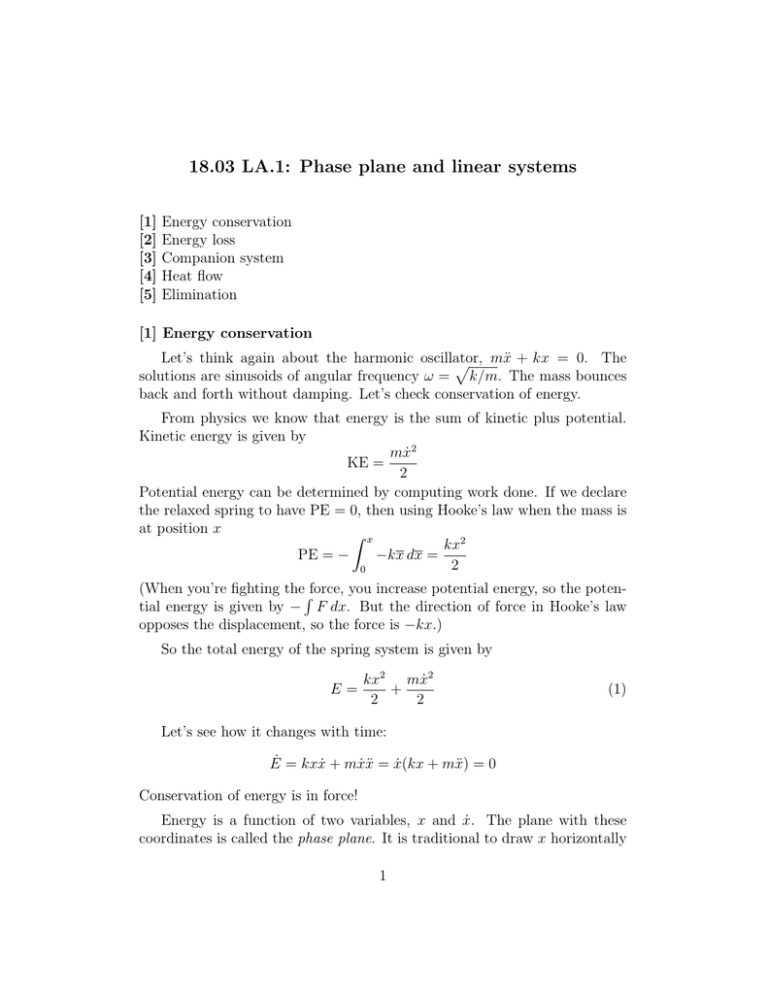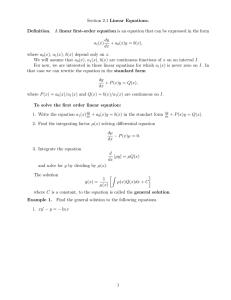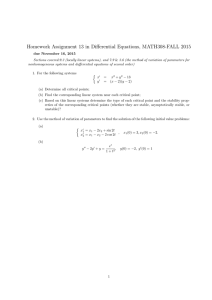18.03 LA.1: Phase plane and linear systems
advertisement

18.03 LA.1: Phase plane and linear systems [1] [2] [3] [4] [5] Energy conservation Energy loss Companion system Heat flow Elimination [1] Energy conservation Let’s think again about the harmonic oscillator, p mẍ + kx = 0. The solutions are sinusoids of angular frequency ω = k/m. The mass bounces back and forth without damping. Let’s check conservation of energy. From physics we know that energy is the sum of kinetic plus potential. Kinetic energy is given by mẋ2 KE = 2 Potential energy can be determined by computing work done. If we declare the relaxed spring to have PE = 0, then using Hooke’s law when the mass is at position x Z x kx2 PE = − −kx dx = 2 0 (When you’re fighting theRforce, you increase potential energy, so the potential energy is given by − F dx. But the direction of force in Hooke’s law opposes the displacement, so the force is −kx.) So the total energy of the spring system is given by E= kx2 mẋ2 + 2 2 (1) Let’s see how it changes with time: Ė = kxẋ + mẋẍ = ẋ(kx + mẍ) = 0 Conservation of energy is in force! Energy is a function of two variables, x and ẋ. The plane with these coordinates is called the phase plane. It is traditional to draw x horizontally 1 and ẋ vertically. Contours of constant energy are curves on this plane, namely ellipses. Rearranging (1), x2 ẋ2 + =1 2E/k 2E/m p so the p maximal value (i.e. the amplitude) of x is 2E/k and the amplitude of ẋ is 2E/m. These are the semi-axes of the ellipse. These formulas make sense: For given energy, small spring constant means big swing; small mass means large velocity. As time increases, the point (x(t), ẋ(t)) traces out this ellipse. Which ellipse depends on the energy. You get a whole family of nested non-intersecting curves. This is called the phase diagram of this system. Question 10.1. In which direction is the ellipse traversed? 1. 2. 3. 4. Clockwise Counterclockwise Depends I don’t know Well, above the axis ẋ > 0, which means that x is increasing. So the answer is 1, clockwise. In a phase diagram, trajectories move to the right above the horizontal axis, and to the left below it. How about when the trajectory crosses the horizontal? Well there ẋ = 0: the tangent is vertical. It crosses at right angles. As the point moves around the ellipse, energy in the system sloshes back and forth between potential (when |x| is large and |ẋ| is small) and kinetic (when |ẋ| is large and |x| is small). [2] Energy loss What happens when we introduce some damping? So now mẍ + bẋ + kx = 0 Our equation for the energy is unchanged, but now Ė = ẋ(kx + mẍ) = −bẋ2 2 (2) Energy is lost to friction. The dashpot heats up. The loss is largest when |ẋ| is largest, and zero when ẋ = 0. The effect of the friction is that the trajectory crosses through the equalenergy ellipses; it spirals in towards the origin, clockwise. The x and ẋ graphs are damped sinusoids, out of phase with each other. Wait, that’s just the underdamped case. The other option is that the trajectory just curves in to zero without spiralling. These are clearly shown in the Mathlet “Linear Phase Portraits: Matrix Entry.” [3] The companion system In introducing ẋ as an independent variable, we’ve done something important. We’ve rewritten the original equation as a first order equation. To be clear about this, let’s write y for the new variable. It’s related to x: y = ẋ. k . What’s ẏ? To keep the notation clean, let me replace b by mb and k by m ẏ = ẍ = −kx − bẋ = −kx − by So we have a pair of linked differential equations, a system of ordinary differential equations. (Sorry about the overuse of the word “system.”) ẋ = y ẏ = −kx − by This is called the companion system of the equation (2). We might as well use vector notation: x ẋ u= so u̇ = y ẏ so we can write our equation using matrix multiplication: 0 1 u̇ = u −k −b The matrix here is the companion matrix of the differential operator D2 + bD + kI. This is pretty amazing! We have replaced a second order equation with a first order (but now vector-valued) equation! 3 You can even incorporate a forcing term: ẍ + bẋ + kx = q(t) translates as ẋ = y ẏ = −kx − by + q(t) 0 1 0 u̇ = u+ −k −b q(t) or Note also that the linear second order equation translated into a linear first order vector valued equation, and that homogeneity is preserved. You can do this with higher order equations too: For a third order equa... tion x + a2 ẍ + a1 ẋ + a0 x = 0, say y = ẋ, z = ẏ, so ż = −a2 z − a1 y − a0 x and x x 0 1 0 d y y = 0 0 1 dt z z −a0 −a1 −a2 Side note: Numerical schemes work with first order equations only. To solve a higher order equation numerically, one replaces it by its companion first order system. We’ll discuss this in December. [4] Heat flow Suppose I have a thermally insulated rod, and I’m interested in how heat flows through it. I’ll install a thermometer every foot, and just think about heat transfers between those points. Suppose for a start that the rod is three feet long. So there are four temperatures, x0 , x1 , x2 , and x3 , to consider. Let’s suppose that the temperatures at the end are fixed, constant, but x1 and x2 are functions of time. Well, the linear or Newtonian approach goes as follows: if x0 > x1 , there will be an upward pressure on x1 that is proportional to the difference x0 −x1 . Independently of this, if x2 > x1 , there will be an upward pressure on x1 that is proportional to the difference x2 − x1 . Putting them together, ẋ1 = k((x0 − x1 ) + (x2 − x1 )) = k(x0 − 2x1 + x2 ) 4 Similarly, ẋ2 = k(x1 − 2x2 + x3 ) This is a linked system of equations, which we can express in matrix form, using d x1 x1 x0 −2 1 =k +k (3) 1 −2 x2 x3 dt x2 A four foot section would lead to x1 −2 1 0 x1 x0 d x2 = k 1 −2 1 x2 + k 0 dt x3 0 1 −2 x3 x4 and you can imagine from this what longer sections would look like. The general picture is this: We have a system whose state is determined not by a single but rather by a vector u of n numbers. (Maybe number x the vector is , but maybe not.) The rate of change of u at time t ẋ is determined by the value of u(t) (and perhaps the value of t), and we will mainly assume that this determination is linear, which means that the equation is u̇ = Au + q(t) where A is an n × n matrix A. The matrix A represents the physical system. q(t) is a “driving term” (perhaps the end point temperatures of the rod). To get a particular solution one has to specify an initial condition, u(0), consisting of n numbers. There is a slight change of convention in force here: We are now isolating the u̇ on the left, and putting everything else—representation of the system and input signal alike—on the right. There’s a sign reversal that happens; this is reflected in the signs in the formula for the companion matrix. First order systems of linear equations incorporate higher order linear differential equations, while giving natural representations of other types of physical phenomena. To gain the deepest possible insight into their behavior, it’s best to develop some of the theory of matrices, especially the square matrices that show up in the model above. 5 [5] Elimination Do you think we can rewrite the equation (3) as a second order equation? Let’s try. Maybe I’ll take x0 = x3 = 0, the homogeneous case. If we succeed: Question 10.2 Do you expect this to be underdamped or overdamped? 1. Underdamped 2. Overdamped Well, do you really expect oscillations in the heat distribution? Let’s see. ẋ1 = −2kx1 + kx2 ẋ2 = kx1 − 2kx2 Let’s try to eliminate x2 . I can use the first equation to solve for it in terms of x1 : kx2 = ẋ1 + 2kx1 . If I substitute this into k times the second equation I get ẍ1 + 2k ẋ1 = k 2 x1 − 2k(ẋ1 + 2kx1 ) or ẍ1 + 4k ẋ1 + 3k 2 x1 = 0 OK, the characteristic polynomial is p(s) = s2 + 4ks + 3k 2 = (s + k)(s + k) so the roots are −1 and −3. Overdamped. General solution: x1 = ae−kt + be−3kt You can always do this; but it’s not very systematic or insightful, and it breaks the symmetry of the variables. Linear algebra offers a better way. 6 M.I.T. 18.03 Ordinary Differential Equations 18.03 Extra Notes and Exercises c Haynes Miller, David Jerison, Jennifer French and M.I.T., 2013 1




